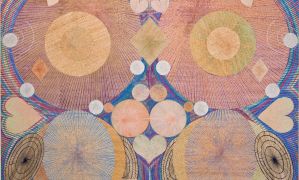Radical: Abstract Art from the Orlando Museum of Art Collection
September 25, 2021 – Ongoing - Martin and Gracia Andersen Lakeview Promenade Gallery
Moon Dance
"Abstraction is staggeringly radical, circumvents language, and sidesteps naming or mere description. It disenchants, re-enchants, detoxifies, destabilizes, resists closure, slows perception, and increases our grasp of the world." - Jerry Saltz, The Jerry Saltz Abstract Manifesto
Throughout most of the 20th century, abstraction was associated with the most risky and progressive developments in modern art. It was often controversial because it seemed to reject a long history of revered ideas about the value and meaning of art. Aesthetic ideas established by centuries of philosophical discourse and artistic achievement were challenged by young artists and their critical champions. From about 1910 to 1970, abstract art grew to become the preeminent practice of the most advanced art of the period. In many ways it came to represent the triumph of the modern era, profoundly influencing every aspect of culture, including not only visual art, but architecture, music, industrial design, and popular media.
This exhibition as well as pieces in the Council of 101 Grand Gallery includes a number of prominent mid-20th century artists such as Morris Louis, Helen Frankenthaler, John Chamberlain, and Jules Olitski, whose careers were established when abstraction was at its apogee. Also included are works by the generations of artists who followed them up to the present. These artists continue to find abstraction relevant as a means of exploring fundamental questions about the nature of art and art making. In the broadest sense, abstract art strives to discover was is essential to the ideas that artists explore in the production of their work. Those ideas, which emerge from each artist's innate interests and creative growth, allow for endlessly varied works. Experimentation and discovery are fundamental to this mode of working and continue to keep the practice vital.
As Jerry Saltz, art critic for the New Yorker Magazine, states "the meaning of abstract art is diverse and mercurial." For many artists meaning is conveyed through a visual language of form and arises from the practice used to create a work. Withouth representational subjects or literal narratives to dictate what a painting or sculpture is about, the artist's process of working becomes a way of determining what to make and how to make it. An artist's practice can be logical as systematic such as Valerie Jaudon's compositions of complex interlocking geometric shapes inspired by the patterns of Islamic tilework. Other artists such as Pat Steir use more formal and intuitive methods of working. Her paintings are composed of drips and spatters made by pressing a wet brush against the canvas. Following a process lets an artist make decisions and move a work of art forward while allowing the unexpected to intervene and change the course of a work. The risk of beginning a work without knowing where it will lead is essential to the radical nature of the best abstract art.





